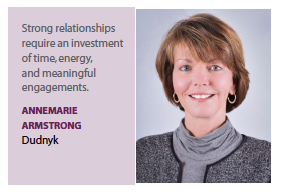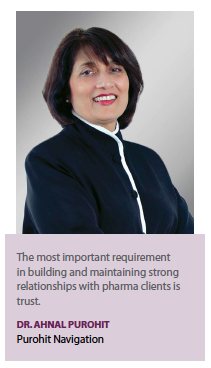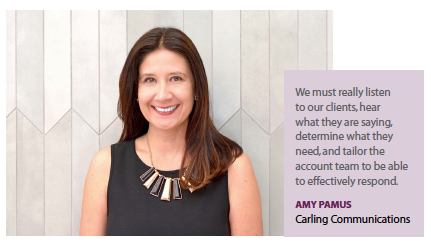We could write a book — and many have — on all of the necessary ingredients to create a successful partnership in the life-sciences space of client-agency relationships. But instead, we’ve asked our thought leaders to focus on three vital issues: what is needed to build and maintain strong relationships with their pharma clients; the challenges specific to client-agency relationships in the life sciences; and the one factor that can make or break a client-agency relationship.
Reports from Forbes, Inc.com, and Mc-Kinsey all provide tips for managing business relationships, and not surprisingly the guidelines for any relationship — personal or professional — include: be honest, be authentic, be flexible, be empathetic, be connected.
According to Karen Carolonza, co-managing partner, Green Room Communications, agencies  understand that pharma clients face many different challenges at once, and may be struggling just to keep up with the pace of both scientific, technologic, and marketing advancements.
understand that pharma clients face many different challenges at once, and may be struggling just to keep up with the pace of both scientific, technologic, and marketing advancements.
She cites escalating drug costs, access to medications, privacy, and compliance as just a few of the issues clients face each day. “To say the life-sciences industry is volatile is an understatement," Ms. Carolonza says.
“As innovations emerge, pharmaceutical clients need to stay informed on trends, be proactive in their communications, and be poised for change — a challenge in today’s digital age and 24/7 news cycle. To be an asset in today’s rapidly changing environment, agencies need to immerse themselves in their clients’ business strategy and understand the pressures of working in this highly regulated environment and network internally and externally to get the job done."
Despite these challenges, both the client and the agency must work to build an effective relationship, states a McKinsey report, “How to get the most from your agency relationships in 2017," calling the relationship “a two-way street." On the pharma side, being a great client involves having a very clear internal operating model. This helps to avoid rework from different parts of the business asking their agency partners for the same things. Regular and ongoing dialogs with agencies are recommended to be proactive and to test, refine, and optimize performance on a continual basis.
In these fast-moving times, pharma clients still need to allow agencies some breathing room to do their best work, even when quick pivots are necessary, the McKinsey report says.
 While quick turnarounds are sometimes essential and inevitable, agencies generally need time and space to be creative. Agencies are crucial partners in driving growth and navigating a complex and still-expanding array of technologies, channels, and platforms, the report concludes.
While quick turnarounds are sometimes essential and inevitable, agencies generally need time and space to be creative. Agencies are crucial partners in driving growth and navigating a complex and still-expanding array of technologies, channels, and platforms, the report concludes.
On the agency side, the bottom line is that clients should want to engage with their agency because the relationship is enjoyable — and the work is excellent, says Amy Pamus, senior VP, client services, at Carling Communications. “Basically, clients want to work with people they like," she says. “Otherwise, the relationship will not be maintained for the long haul."
Ms. Pamus says an agency’s job is to make the client’s life easier, anticipate its needs, provide value, and help drive business. “Being thoughtful about your interaction with each client is important, as is also getting to know the client on a personal level," she adds.
The personal touch can go a long way in building relationships, says Annemarie Armstrong, executive VP, director of client services, Dudnyk.
“Agencies need to develop and convey a deep understanding of the client’s business right from the start, or else there is no base to build your relationship from," she says. “Strong relationships require an investment of time, energy, and meaningful engagements."
Developing a good relationship requires knowing what is going on in the clients’ world, determining how they like to communicate, and learning and adapting to their style of doing business. “Personal styles may be different, but the agency team should be the one to adapt, not the client," Ms. Armstrong says. “Adaptability helps tremendously in being able to anticipate clients’ needs and respond to their feedback."
“Strong customer service is about understanding your clients and proactively helping them to meet their business needs and challenges," Ms. Pamus says. “We need to really listen to our clients, hear what they are saying, determine what they need, and tailor the account team to be able to effectively respond."
Another key to maintaining strong client relationships is committing to and building modern bespoke strategic creative teams, and to flex and scale those teams over time to meet clients’ needs.
For Colleen Carter, chief experience officer at Concentric, this means proactively investing in a robust pool of talent across technology, insights, cognitive psychology, experience planning, access, and much more to ensure that the team is able to constantly deliver the most effective marketing solutions. “At the end of the day, successful client relationships are a result of successful clients, so we focus on using every tool at our disposal to support our clients and to make what we do on their behalf matter," she says.
Challenges Specific to Life-Sciences Partners
Agencies that work with life-sciences marketing teams need to be knowledgeable of the specific challenges the industry faces. It is extremely helpful when members of the agency staff have come from the pharma industry and have the built-in knowledge to address the hurdles that the industry faces. Managing brand planning, campaigns, and messaging within a highly regulated industry certainly has its challenges. However, agency teams can learn the ropes without prior pharma experience, and meeting these challenges offers greater opportunity for the agency to serve the client.
“For agency teams working in the life sciences, there is an expectation that we not only understand  and can counsel brand teams on marketing strategy, but that we can also work with the various roles within a life-sciences organization," Ms. Armstrong says. “This means working with commercial analytics, sales leadership, patient advocacy, and partnering with medical affairs — and being able to discuss strategy and tactics with them in a way that is on par with their own professional experience."
and can counsel brand teams on marketing strategy, but that we can also work with the various roles within a life-sciences organization," Ms. Armstrong says. “This means working with commercial analytics, sales leadership, patient advocacy, and partnering with medical affairs — and being able to discuss strategy and tactics with them in a way that is on par with their own professional experience."
Another challenge specific to life-sciences clients is the higher burden of proof required than other industries, whether from the FDA in terms of product claims, or within their internal company environment, such as legal and regulatory reviews of promotional materials. To avoid pitfalls and to get it right the first time, the agency needs to be deeply experienced with the internal and external regulatory frameworks so that the work meets the expectations and requirements of all key stakeholders, says Ahnal Purohit, Ph.D., CEO, Purohit Navigation.
Agencies need to have a broad understanding of the “Cs" Ms. Armstrong adds, meaning that they must be well-informed on the category, the competition, the customer, the company, and the compound. “If the agency team doesn’t understand even one of those Cs, there is a real risk of falling short of client expectations," she says.
Working with a promotional review committee (PRC) or a medical, legal, regulatory (MRL) review committee is a challenge that is unique to the life sciences. The PRC team is tasked with protecting the client from potential liability by ensuring the accuracy of all claims, while the agency tries to craft the best story that will change behavior of healthcare professionals, patients, and consumers.
“Agencies need to be mindful that the PRC committee is doing its job when it challenges the wording of a claim or its support," Ms. Pamus says. “When both groups are open-minded and respect the challenges faced by the other, collaboration can flourish, and quality work is the result."
Pharma clients are engaging with a large number of stakeholders and a wide variety of audiences, from patients and healthcare practitioners to advocates, payers, and prospective talent pools across a multitude of platforms. Add to that social media, and there is another challenge from a compliance perspective. When patients reach out to one another online for information and support, this provides an opportunity for pharma companies to connect with them.
“However, an understanding of industry best practices — what works and what doesn’t — is necessary to face these challenges," Ms. Carolonza says. “It takes creativity to break through the online clutter, but it also requires a strategic approach."
The challenges the industry face today are very different from even five years ago, Ms. Carter says.
“The advent of the digital age along with the changes in the healthcare environment with respect to payers and physicians have created great complexity, as well as an unprecedented opportunity for agency partners to support clients," she says. “We’re looking at a very different world now, and with this change comes a different set of marketing challenges. There is the sheer breadth and variety of stakeholders combined with the complexity of the healthcare ecosystems in which clients operate, from individual stakeholders who range from specialists, to nurses, payers, patients, pharmacists, and IDNs, where relationships at the C-suite level are critical. Then, add to that the rise of technology-enabled care, such as telemedicine and the impact and opportunity of an always-connected world. When an agency can consolidate all of these disciplines under one roof, it can create a more efficient and integrated solution, thereby reducing the burden on clients and delivering more effective and creative strategic solutions."
Trust: The Make or Break Factor
Interestingly, when we asked our experts to identify the one aspect that could make or break a pharma client relationship, they all named the same factor: trust.
“The most important requirement in building and maintaining strong relationships with pharma clients is trust," Dr. Purohit says. “Listening to the client can make or break the relationship. When clients make a request or provides feedback on something, you as the agency must put aside your own creative tendencies and impulses and listen to them. They have a deeper understanding of their vision and idea of success, as well as any sensitivities and internal politics that might come into play."
For today’s pharma marketers who have to work at the intersection of innovation and regulation, trust is key to successful client-agency relationships, Ms. Carter says. To effectively compete today, marketers should be leveraging the most effective engagement strategies and technologies; in many cases, these innovations can be the first within an organization. “Clients need to be able to trust that their agency partner fully understands the environment and can innovate responsibly to truly deliver marketing excellence required in 2018 and beyond," she says.
Ms. Armstrong puts it simply: Building trust forms a relationship; losing trust breaks a relationship. “If clients feel as though they always need to get the agency up-to-speed or must explain implications of a market shift for their business, the more difficult it will be to build trust," she adds. “Having a solid agency staffing plan in place — the right account leadership and support, the right strategy, the right scientific, and creative talent for the business — is critical to ensuring there is a foundation for a strong, trustful relationship."
The groundwork for trust must start from the first meeting on, and continue throughout the engagement, as every interaction factors into the health and stability of the relationship, Ms. Carolonza adds. Earning trust takes time, dedication, and focus to build a trusting relationship, whether between a client and external agency, up the corporate ladder, or across functions and teams.
Ms. Pamus adds that communication is also a factor in building trust within a client-agency relationship.
“Poor communications will eventually foster an atmosphere of distrust and hostility," she says. For example, if a new client doesn’t provide its agency with the necessary in-house data to create the best brand story, or an agency fails to alert the client that it won’t be able to deliver an initiative on time the relationship is sure to falter. Or if the client provides feedback that lacks specific examples of what they don’t like, or the agency doesn’t discuss cost overruns, but instead, sends a revised invoice, bad feelings can develop between the two parties. “The client will begin to believe that the agency ‘just can’t get it right’ and will begin to lose confidence that their agency is the right partner for their brands," Ms. Pamus concludes.
Strategic communications directly impact business objectives and are a critical function in today’s complex multimedia world.
“To be truly strategic and maintain a strong relationship with pharmaceutical and life-sciences clients, it’s necessary to come from a place of partnership," Ms. Carolonza says. “Good agencies should always strive to become extensions of their clients’ teams."(PV)
~~~~~~~~~~~~~~~~~~~~~~~~~
ALWAYS and NEVER: Rules For Effective Relationships
ALWAYS
Find a way to connect with clients on a personal level, earn their trust, and lead; it makes the inevitable tough conversations authentic and based on an established partnership.
Annemarie Armstrong
Executive VP, Director of Client Services, Dudnyk
Be open and honest with your partners, which includes setting clear expectations with check-ins along the way to create opportunities for regular feedback.
Karen Carolonza
Co-Managing Partner, Green Room
Communications
Own the truth. The day you can’t have an honest conversation with your client or your team is the day the relationship starts to falter. If you’ve got trust, you can be honest. Try it. It works.
Colleen Carter
Chief Experience Officer, Concentric
Verify you truly understand what your client’s needs are to help them meet their business challenges.
Amy Pamus
Senior VP, Client Services, Carling
Communications
Be fully present in every interaction with your client.
Ahnal Purohit, Ph.D.
CEO, Purohit Navigation
NEVER
Never take client relationships for granted; we must earn their business — and their trust — every day.
Annemarie Armstrong
Executive VP, Director of Client Services, Dudnyk
Never think of communications in a vacuum; communications sync with advertising, search engine optimization, key messages, digital, and more to keep content consistent while providing a surround-sound, integrated approach with greater impact and ROI.
Karen Carolonza
Co-Managing Partner, Green Room
Communications
Never assume that what was effective today will be effective tomorrow. The expression “change or die" is dramatic for a reason. Keep thinking, keep innovating, keep asking great questions. Your relationships will be stronger because of these actions.
Colleen Carter
Chief Experience Officer, Concentric
Never get lackadaisical in your thinking or settle for “good enough" work.
Amy Pamus
Senior VP, Client Services, Carling
Communications
Never be satisfied with just meeting requirements or expectations.
Ahnal Purohit, Ph.D.
CEO, Purohit Navigation



















